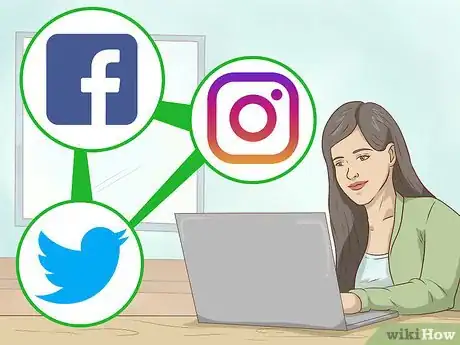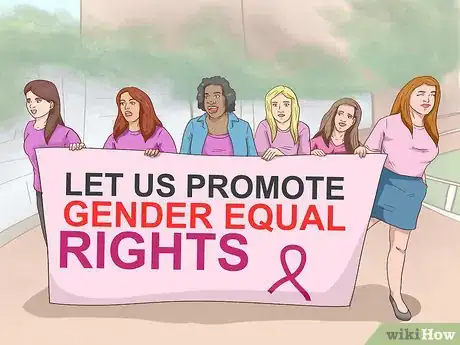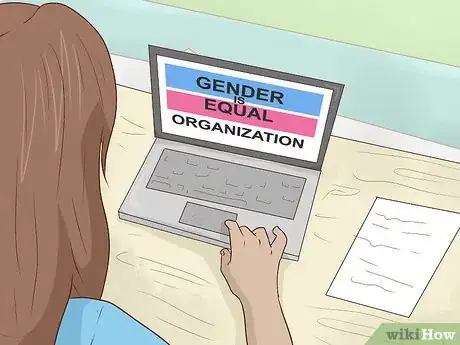This article was co-authored by Marissa Floro, PhD. Dr. Marissa Floro, Ph.D. is a Psychologist and Instructor at Stanford University’s Weiland Health Initiative and adjunct faculty at the University of San Francisco. Dr. Floro received her Ph.D. in Counseling Psychology from Loyola University Chicago, focusing on the intersections of race, attraction, and gender. Dr. Floro’s continued clinical, teaching, and advocacy work focuses on sexual and gender diversity, racial identity and belonging, and liberation from oppressive systems and structures.
There are 17 references cited in this article, which can be found at the bottom of the page.
This article has been viewed 63,458 times.
Promoting gender equality is a movement that people are focusing on around the globe. Since this is so large scale, you might be wondering what just one individual can do. There are actually a lot of things you can do to make a difference! Unfortunately, it's likely that you've either witnessed gender inequality or even been a victim. It's frustrating, and can be really hard to cope with. The good news is that you can make a change. The time to get started is now!
Steps
Being a Vocal Advocate for Equality
-
1Learn about gender equality. If you’re standing up for gender equality, it’s important to educate yourself. Take some time to learn about some of the major issues, such as inequality in the workplace and the cost of healthcare. You can read scholarly articles about the subject because you want an expert, objective take on the subject.
- You can get started by researching gender equality online. Pull up articles using search engines such as Google Scholar or an academic database like JSTOR.
- You could also take a course on gender either at your local college or online.
-
2Educate others about gender equality. You can share what you’ve learned with others. This doesn’t mean you should go around lecturing everyone you meet, but you can definitely correct misconceptions.
- For example, if someone at work says they don’t believe that the wage gap is true, you could say, “Actually, it is true that statistically women are paid less than men. Here, let me show you this interesting article I read on the subject.”
- Make sure not to dominate the conversation. Other people might have helpful information to share, too. Be ready to listen.
Advertisement -
3Speak up if you witness sexism. You likely witness examples of sexism every day. It could be in the form of gender stereotypes, inappropriate comments, or unwanted advances. If you see something that seems off, it probably is. Don’t be afraid to speak up. [1]
- Maybe you've seen one of your friends put down a female sports reporter. Speak up and say, "Women are just as qualified as men to talk about baseball."
- You might feel objectified if someone on the street catcalls you. You have the right to say, "Stop!"
- For example, if you are at a bar and a patron keeps touching a female server, you could say, “Excuse me, she’s trying to do her job. Let’s keep things professional.”
- Be aware of safety. If the person seems volatile, don't confront them. Your safety is the most important thing.
-
4Use social media as your platform. You can use your social media accounts to promote gender equality. One way is to share information about upcoming events. You could post a link to a women’s march in your area and say, “I’ll be there! Who wants to join me?”
- You can also support large social media campaigns such as #MeToo. If someone you know shares their story, offer a supportive statement.[2]
-
5Educate yourself about intersectionality. Intersectionality means that all aspects of identity must be considered, especially when examining oppression. For example, a Latina women cannot separate her ethnicity from her gender identity. Both must be considered when looking at the specific challenges she faces. These pieces of identify intersect.[3]
- Avoid making feminism about groups of people in power. If you are a white cis person, make sure to include other groups in your discussions so that you can understand different perspectives and experiences.
-
6Promote the rights of trans and nonbinary people. Remember that not everyone fits into the traditional gender binaries. When promoting gender equality, support trans and nonbinary people in the following ways:[4]
- Don't assume someone's gender
- If you're not sure of pronouns, listen or ask
- Respect the person's terminology
- Support gender-neutral restrooms
Promoting Gender Equality in the Workplace
-
1Listen to women. Sometimes women struggle to be heard in the workplace. They are more likely to be interrupted or dismissed. Be an advocate for the women in your workplace.[5]
- If you see a woman trying to break into the conversation, say, “I’d like to hear additional thoughts on the issue. Julie, what do you think?”
-
2Make sure women receive credit for their ideas and work. Women often are not given enough credit for what they do in the workplace. If your female-identifying colleague comes up with an innovative way to streamline office communication, take some time at the next team meeting to say, "Let's all thank Kate for her great ideas about implementing this new system."[6]
-
3Give women constructive feedback. People tend to give women vague feedback, such as simply saying “good job” or “you need to improve.” Men typically receive much more specific feedback, which helps them to improve. Make it a point to give the women you work with helpful feedback.[7]
- If you’re a manager, you might say, “I really liked your ideas about how to improve productivity. Next time the subject comes up, I’d like you to volunteer to take the lead on implementing changes.”
-
4Challenge gender expectations. Women are much more likely than men to receive negative comments about their personality. For example, a strong woman might be labeled “bossy” or “shrill”. The next time you hear someone make comments like this about a woman, ask them for a specific example. You can also say, “Would you have the same reaction if a man had acted the same way?” [8]
-
5Celebrate and encourage women. Women often don’t get enough credit for their accomplishments in the workplace. Make sure to acknowledge their contributions. You could say, “Julie brought in the most new accounts this year. Let’s all give her a round of applause.” [9]
- Help increase female confidence by encouraging them to go for promotions or new positions. You could say, “You definitely have what it takes to be the team lead. You should apply!”
Becoming Politically and Socially Active
-
1Use your vote to support inclusive candidates. Do your research on candidates and find out where they stand on women’s rights. Support those candidates by voting for them. One of the best ways to implement change is to get more people into office who are willing to fight for gender equality. [10]
- Remember to vote in local, state, and national elections. They’re all important!
-
2Contact your representatives about important policies and legislation. Let your representatives know that gender equality is an important issue to you. Reach out to them and ask them to stand up for gender equality. You can call or email your representatives. You can also make an appointment to visit them in person at their office.[11]
- For example, you can call your Senator to voice your views on funding for Planned Parenthood. You can say, "I am your constituent and I want you to work to make sure Planned Parenthood receives more funding."
-
3Attend marches or rallies. Look for events that are being held near you. There might be a rally about women’s healthcare or about equal pay. Go to a march or rally and take some friends with you! This is a great way to show your support for gender equality. [12]
-
4Join an organization that promotes gender equality. Many workplaces have groups for females. These groups can be for women to talk about issues that they are dealing with and also a time for women to support each other. Ask around to see if your office has a group like this. If not, ask if you can start one. [13]
- Most colleges and universities will also have these types of groups. Many even have a women’s center, which will sponsor events that promote gender equality.
-
5Run for office. If you want to enact change, holding office is a great way get started. You can start by running for city council or the school board. Or shoot for the stars and run for a state or national office. There are lots of resources out there to help you with your first campaign. Check out Emily’s List and Run for Something for help. [14]
Finding Causes to Support
-
1Research different organizations that focus on supporting gender equality. There are many ways that you can make a difference in your community, but don't forget that this is a global issue. Take some time to look for organizations whose mission you agree with before supporting them.[15]
- You can start with a simple Google search. Read the “About” section on websites, and take a look at what the organization stands for.
- Maybe you've heard about the Time's Up movement. Check out their website to see exactly how their legal defense fund will help people dealing with sexual harassment, abuse, or inequality in the workplace.[16]
- You can broaden your search to look for organizations that work on more specific issues. You could look for an organization that helps victims of domestic violence, for example.
-
2Donate money to a cause by making an online donation or writing a check. Once you’ve found an organization you’d like to support, you can make a difference by donating money. You can make a one-time donation or set up a recurring option.[17]
- For example, if you are interested in supporting women’s healthcare, make a donation to Planned Parenthood. You can simply click on the "Donate" button on their website.
- Your monetary donation will help ensure that people can receive affordable health care for things like pap smears and breast exams.
- If you can’t afford to give money, give your time. Contact the organization and ask how you can volunteer.
-
3Raise money for an organization by fundraising. There are many ways to raise money. You could collect donations and organize a silent auction, or you could try posting about an organization on social media. Raising funds will allow you to donate more money so that the organization you've chosen can continue its work. It will also help bring more awareness to the cause.[18]
- Try making a post on social media saying, “To celebrate my birthday this year, I’d love it if my friends and family can support the cause that is important to me.” Add a link where they can simply click to donate.
Expert Q&A
-
QuestionHow do I educate myself about gender equality in the workplace?
 Marissa Floro, PhDDr. Marissa Floro, Ph.D. is a Psychologist and Instructor at Stanford University’s Weiland Health Initiative and adjunct faculty at the University of San Francisco. Dr. Floro received her Ph.D. in Counseling Psychology from Loyola University Chicago, focusing on the intersections of race, attraction, and gender. Dr. Floro’s continued clinical, teaching, and advocacy work focuses on sexual and gender diversity, racial identity and belonging, and liberation from oppressive systems and structures.
Marissa Floro, PhDDr. Marissa Floro, Ph.D. is a Psychologist and Instructor at Stanford University’s Weiland Health Initiative and adjunct faculty at the University of San Francisco. Dr. Floro received her Ph.D. in Counseling Psychology from Loyola University Chicago, focusing on the intersections of race, attraction, and gender. Dr. Floro’s continued clinical, teaching, and advocacy work focuses on sexual and gender diversity, racial identity and belonging, and liberation from oppressive systems and structures.
Counseling Psychologist Do some outside research so you don’t burden your colleagues; learn about the difference between sex assigned at birth, gender identity, and gender expression. Educate yourself on the gender binary and how it oppresses everyone, especially transgender and gender non-conforming people of color. Continue to learn about sexual and gender diversity across culture and history and how it has been erased or whitewashed. Consume media, entertainment, and news from trans and gender non-conforming people.
Do some outside research so you don’t burden your colleagues; learn about the difference between sex assigned at birth, gender identity, and gender expression. Educate yourself on the gender binary and how it oppresses everyone, especially transgender and gender non-conforming people of color. Continue to learn about sexual and gender diversity across culture and history and how it has been erased or whitewashed. Consume media, entertainment, and news from trans and gender non-conforming people. -
QuestionHow can I take action in my office to promote gender equality?
 Marissa Floro, PhDDr. Marissa Floro, Ph.D. is a Psychologist and Instructor at Stanford University’s Weiland Health Initiative and adjunct faculty at the University of San Francisco. Dr. Floro received her Ph.D. in Counseling Psychology from Loyola University Chicago, focusing on the intersections of race, attraction, and gender. Dr. Floro’s continued clinical, teaching, and advocacy work focuses on sexual and gender diversity, racial identity and belonging, and liberation from oppressive systems and structures.
Marissa Floro, PhDDr. Marissa Floro, Ph.D. is a Psychologist and Instructor at Stanford University’s Weiland Health Initiative and adjunct faculty at the University of San Francisco. Dr. Floro received her Ph.D. in Counseling Psychology from Loyola University Chicago, focusing on the intersections of race, attraction, and gender. Dr. Floro’s continued clinical, teaching, and advocacy work focuses on sexual and gender diversity, racial identity and belonging, and liberation from oppressive systems and structures.
Counseling Psychologist Question and make changes to processes, systems, and traditions in the workplace. This could involve questioning why bathrooms are separated by gender, including pronouns in introductions or email signatures, challenging colleagues who make assumptions about gender and sexuality, and expanding language so that it's not gendered (e.g. using “folks” instead of “ladies and gentlemen” and “partner” instead of “wife/husband"). What’s most important in promoting gender equality is listening to the experiences and suggestions of those who are most marginalized by gendered systems.
Question and make changes to processes, systems, and traditions in the workplace. This could involve questioning why bathrooms are separated by gender, including pronouns in introductions or email signatures, challenging colleagues who make assumptions about gender and sexuality, and expanding language so that it's not gendered (e.g. using “folks” instead of “ladies and gentlemen” and “partner” instead of “wife/husband"). What’s most important in promoting gender equality is listening to the experiences and suggestions of those who are most marginalized by gendered systems.
Warnings
- It takes real courage to speak out against discrimination and people may imply that you are just causing problems. Don't let this stop you.⧼thumbs_response⧽
- Safety is the most important no matter what. Don't confront anyone who may respond violently.⧼thumbs_response⧽
References
- ↑ https://www.girlsglobe.org/2015/12/25/five-ways-to-promote-gender-equality-in-2016/
- ↑ https://www.pewresearch.org/social-trends/2022/09/29/more-than-twice-as-many-americans-support-than-oppose-the-metoo-movement/
- ↑ https://everydayfeminism.com/2015/01/why-our-feminism-must-be-intersectional/
- ↑ Marissa Floro, PhD. Counseling Psychologist. Expert Interview. 18 February 2021.
- ↑ https://leanin.org/tips/workplace-ally
- ↑ https://www.weforum.org/agenda/2022/11/5-tips-on-helping-close-the-gender-gap/
- ↑ https://www.weforum.org/agenda/2016/10/managers-give-women-less-feedback-gender-bias-in-performance-reviews/
- ↑ https://www.mediasupport.org/the-crucial-role-of-media-in-achieving-gender-equality/
- ↑ https://gsdrc.org/topic-guides/gender/understanding-gender/
- ↑ https://www.girlsglobe.org/2015/12/25/five-ways-to-promote-gender-equality-in-2016/
- ↑ https://www.usa.gov/elected-officials
- ↑ https://www.womensmarch.com/
- ↑ https://news.yale.edu/2017/10/17/yale-women-faculty-forum-promoting-gender-equity-campus-and-research
- ↑ https://www.emilyslist.org/pages/entry/run-for-office
- ↑ https://geia.elliott.gwu.edu/recommended-organizations/
- ↑ https://www.timesupnow.com/
- ↑ https://www.globalfundforwomen.org/get-involved/give-now/other-ways-to-give/
- ↑ https://www.womankind.org.uk/8-ways-to-change-the-course-for-womens-rights/








































































